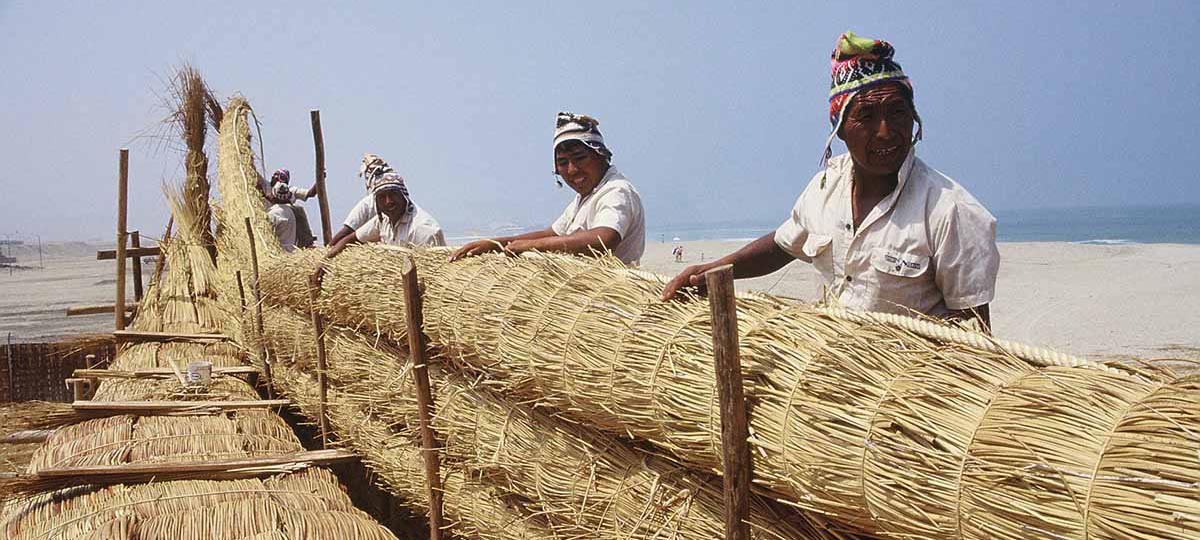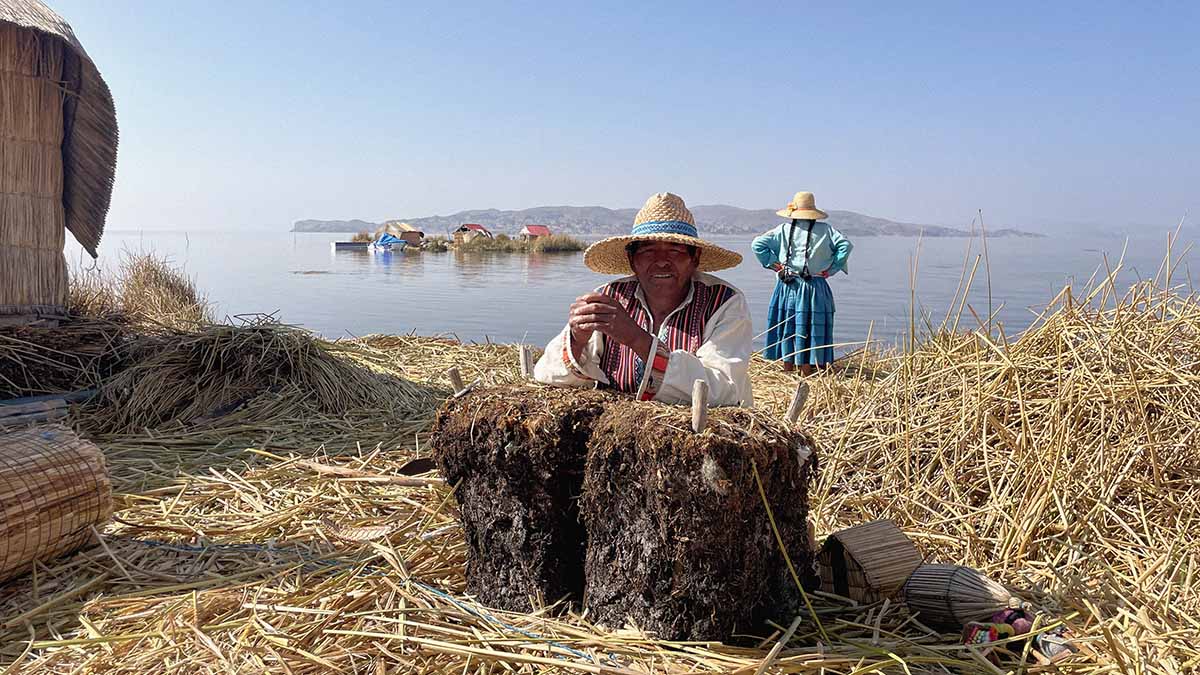Submitted by WA Contents
Peru Pavilion will unfold the ancestral techniques of the Uros and Aimara communities
Peru Architecture News - Apr 28, 2025 - 05:16 4953 views

The Peruvian curators, Alex Hudtwalcker (Lead Curator), Sebastián Cillóniz, Gianfranco Morales, and José Ignacio Beteta, along with the Patronato Cultural del Perú (pacupe), have announced the theme for the Peru Pavilion at the 2025 Venice Architecture Biennale.
Titled Living Scaffolding, in the Venice Arsenale, Living Scaffolding creates a huge wooden scaffold. The distilled knowledge of the Uros and Aimara people, who live around Lake Titicaca in the Peruvian highlands, more than 3800 meters above sea level, is infused throughout this work.

Antonio Jallahui, leader of the Uros-Titino island on Lake Titicaca with a totora reed block that makes up the island’s underwater structure. Photo Curatorial Team
The setting, known as the highest navigable body of water in the world, allows the curators to respond to curator Carlo Ratti's call for "One Place, One Solution."
It showcases the region as a living epicenter of ancestral knowledge, which has achieved remarkable accomplishments through the sophisticated and refined use of totora, a material that has been utilized since ancient times.
Curatorial Team. From left to right: Alex Hudtwalcker, Gianfranco Morales, Sebastián Cillóniz, Jose Ignacio Beteta. Photo courtesy of PUCP
The show at the Sala d'Armi, the location for the Peru Pavilion, will run from May 10 to November 23, 2025. José Orrego Herrera, a Peruvian architect who has been the commissioner since 2012, will take on the position once more.
Eric Frattini, The Uru Expedition led by Kitin Muñoz, 1988. Aimara artisans working over the scaffolding of the totora reed raft in Punta Negra beach, Lima. Photo Eric Frattini. Private Collection. Courtesy of Eric Frattini
The building of the giant Uru totora reed raft, which embarked on an unprecedented sea trip in 1988 to connect South America and Polynesia, is revisited in the show. The ship was constructed on a beach south of Lima and sailed for 54 days. Dozens of workers labored for several weeks amidst massive bundles of hemp, lumber, and totora ropes. A key component of this team effort was a massive wooden scaffold that allowed eight Aimara craftsmen to work together to create a 10-ton, 20-meter-long raft.
To construct the raft, these craftspeople, who were skilled in the usage of totora, a material vital to their cultural legacy, turned to their ancestors' wisdom. The Uros floating islands on Lake Titicaca were constructed using techniques similar to theirs. These islands, which are primarily composed of totora, are a live example of a self-renewing, cyclical architectural system that preserves information that is impervious to time and the elements. The intricacy of these structures, however, comes from their versatility rather than their permanence.
Eric Frattini, The Uru Expedition led by Kitin Muñoz, 1988. Volunteers and expeditioners working alongside the artisans above the scaffolding of the totora reed raft. Photo Eric Frattini. Private Collection. Courtesy of Eric Frattini
Totora is a subspecies of the giant bulrush sedge, found primarily in South America. It grows in regions such as Lake Titicaca, the central coast of Peru, and Easter Island in the Pacific Ocean. This plant can reach heights of up to 6 meters (20 feet), though it typically grows to around 4 meters.
Both the raft and the islands, which are prone to natural deterioration, depend on little but necessary auxiliary structures, materials, and instruments that blend in with and support these floating bodies, enabling these enormous endeavors.
Similar to how the wooden scaffold was required to assemble the raft, the islands need supporting structures to stay moored while they are being built. Craftspeople, volunteers, and explorers were able to move above and below the raft and modify its components thanks to this system.
Eric Frattini, The Uru Expedition led by Kitin Muñoz, 1988. Great Uru raft on the large wooden scaffold. The raft was 20 meters long, 4 meters wide, and weighed 10 tons. Photo Eric Frattini. Private Collection. Courtesy of Eric Frattini
The wooden scaffolding, similar to that used to build the Uru totora reed raft or the stilts that hold Venice in place, takes on new life and significance at the Arsenale, where ships were previously built on the sea. It recalls the memory of long-gone volumes of totora, together with the same ropes and timbers used to stabilize the islands.
Visitors are encouraged to look at, live in, and surround the piece, which echoes the methods used by Aimara artisans to construct the raft and the methods now used by the people of the Uros islands to construct and maintain their floating dwellings.
Eric Frattini, The Uru Expedition led by Kitin Muñoz, 1988. Launch at the Callao Nautical Club in Lima to begin its journey to French Polynesia. Photo Eric Frattini. Private Collection. Courtesy of Eric Frattini
Lean Curator Alex Hudtwalcker is an architect by Universidad Peruana de Ciencias Aplicadas (UPC) and master in Science in Advanced Architectural Design by Columbia University in New York, where he received the Honour Award for Excellence in Advanced Architectural Design. He leads Alex Hudtwalcker Architects, collaborating with local architects and international offices.
Sebastián Cillóniz is architect and professor. He earned his degree from Pontificia Universidad Católica del Perú (PUCP) and holds a master’s degree in Science in Advanced Architectural Design from Columbia University in New York. He currently teaches design and theory at PUCP and is the director and principal architect at Sebastián Cillóniz Arquitectura.
Eric Frattini, The Uru Expedition led by Kitin Muñoz, 1988. Uru raft sailing. Photo Eric Frattini. Private Collection. Courtesy of Eric Frattini
José Ignacio Beteta holds a Master’s degrees in Public Administration by UPC – Peru and Public Management by Universidad Politécnica de Cataluña. Finally, Gianfranco Morales ia an architect by UPC with a master’s degree in Architecture from Pontificia Universidad Católica de Chile. His academic background includes studies at ETSAM (Madrid), PUCP (Lima) and ETSAB (Barcelona), among others.
Eric Frattini, The Uru Expedition led by Kitin Muñoz, 1988. Uru raft sailing. Photo Eric Frattini. Private Collection. Courtesy of Eric Frattini
Eric Frattini, The Uru Expedition led by Kitin Muñoz, 1988. Aimara artisans working over the scaffolding of the totora reed raft in Punta Negra beach, Lima. Photography by Eric Frattini. Private Collection. Courtesy of Eric Frattini
The 2025 Venice Architecture Biennale will take place from May 10 to November 23 November 2025 at the Giardini, the Arsenale and various venues in Venice, Italy.
Besides Peru's contribution, other contributions at the Venice Architecture Biennale include Switzerland's Endgültige Form wird von der Architektin am Bau bestimmt, Iceland's exhibition Lavaforming, Estonia's Let Me Warm You exhibition, the Romanian Pavilion's "Human Scale" exhibition, the Luxembourg Pavilion's Sonic Investigations exhibition, the Albanian Pavilion's "Building Architecture Culture" exhibition, the Turkey Pavilion's "Grounded" exhibition, the Pavilion of the United Arab Emirates's "Pressure Cooker" exhibition, the Finland Pavilion's "The Pavilion – Architecture of Stewardship" exhibition.
Find out all exhibition news on WAC's Venice Architecture Biennale page.
> via Peru Pavilion
exhibition pavilion Peru Pavilion raft Venice Architecture Biennale
